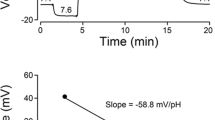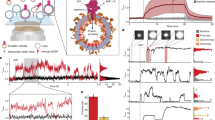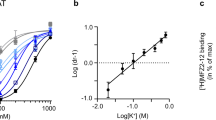Abstract
Efficient control of synaptic transmission requires a rapid mechanism for terminating the actions of neurotransmitters. For amino acids and monoamines, this is achieved by their uptake into the cell by specific high-affinity transporters1; acetylcholine is first broken down in the extracellular space and then choline is taken up by the cell2. Because ATP is hydrolysed to adenosine by membrane-bound enzymes (ectonucleotidases) that are present in most tissues3,4, it has been assumed that these enzymes terminate the neurotransmitter actions of ATP in the brain5 and in the periphery6,7. We show here, however, that stimulation of sympathetic nerves innervating the guinea-pig vas deferens releases not only neuronal ATP, but also soluble nucleotidases that break down this ATP to adenosine, indicating that inactivation of ATP is increased by nerve activity. This release of specific nucleotidases together with ATP represents a new mechanism for terminating the actions of a neurotransmitter.
This is a preview of subscription content, access via your institution
Access options
Subscribe to this journal
Receive 51 print issues and online access
$199.00 per year
only $3.90 per issue
Buy this article
- Purchase on Springer Link
- Instant access to full article PDF
Prices may be subject to local taxes which are calculated during checkout
Similar content being viewed by others
References
Amara, S. G. & Kuhar, M. J. Neurotransporters: recent progress. Annu. Rev. Neurosci. 16, 73–93 (1993).
Bowman, W. C. & Rand, M. J. Textbook of Pharmacology 2nd edn., 10.1–10.8 (Blackwell, Oxford, 1980).
Ziganshin, A. U., Hoyle, C. H. V. & Burnstock, G. Ecto-enzymes and metabolism of extracellular ATP. Drug Dev Res. 32, 134–146 (1994).
Plesner, L. Ecto-ATPases: identities and functions. Int. J. Cytol. 158, 141–214 (1995).
Edwards, F. A., Gibb, A. J. & Colquohoun, D. ATP receptor- mediated synaptic currents in the central nervous system. Nature 359, 144–146 (1992).
Burnstock, G. Purinergic mechanisms . Annals NY Acad. Sci. 603, 1–17 (1990).
Westfall, T. D., Kennedy, C. & Sneddon, P. Enhancement of sympathetic purinergic neurotransmission in the guinea-pig isolated vas deferens by the novel ecto ATPase inhibitor ARL 67156. Br. J. Pharmacol. 117 867–872 (1996).
Sneddon, P., McLaren, G. J. & Kennedy, C. Purinergic cotransmission: sympathetic nerves. Semin. Neurosci. 8, 201–205 (1996).
Gordon, J. Extracellular ATP: effects, sources and fate. Biochem. J. 233, 309–319 (1986).
Kennedy, C. & Leff, P. How should P2x-purinoceptors be characterized pharmacologically? Trends Pharmacol. Sci. 16, 168–174 (1995).
Pearson, J. D., Coade, S. B. & Cusack, N. J. Characterization of ectonucleotidases on vascular smooth muscle cells. Biochem. J. 230, 503–507 (1985).
Welford, L. A., Cusack, N. J. & Hourani, S. M. O. ATP analogues and the guinea-pig taenia coli: a comparison of the structure activity relationships of ectonucleotidases with those of the P2-purinoceptor. Eur. J. Pharmacol. 129, 217–224 (1986).
Welford, L. A. Cusack, N. J. & Hourani, S. M. O. The structure- activity relationships of ectonucleotidases and of excitatory P2-purinoceptors: evidence that dephosphorylation of ATP analogues reduces pharmacological potency. Eur J. Pharmacol. 141, 123–130 (1987).
Todorov, L. D., Mihaylova-Todorova, S., Craviso, G. L., Bjur, R. A. & Westfall, D. P. Evidence for the differential release of the cotransmitters ATP and noradrenaline from sympathetic nerves of the guinea-pig vas deferens. J. Physiol.(Lond) 496, 731–748 (1996).
Misumi, Y., Ogata, S., Hirose, S. & Ikehara, Y. Primary structure of rat liver 5' nucleotidase deduced from the cDNA. J. Biol. Chem. 265, 2178–2183 (1990).
Misumi, Y., Ogata, S., Ohkubo, K. Hirose, S. & Ikehara, Y. Primary structure of human placental 5'- and identification of the glycolipid anchor in the mature form. Eur J. Biochem. 191, 563– 569, (1990).
Crack, B. E. et al. Pharmacological and biochemical analysis of FPL 67156, a novel, selective inhibitor of ecto-ATPase . Br. J. Pharmacol. 114, 475–481 (1995).
Khakh, B. S., Michel, A. D. & Humphrey, P. P. A. Inhibition of ectoATPase and Ca-ATPase in rat vas deferens by P2-purinoceptor antagonists . Br J. Pharmacol. 115, 2P (1995).
Hourani, S. M. O. & Chown, J. A. The effects of some possible inhibitors of ectonucleotidases on the breakdown and pharmacological effects of ATP in the guinea-pig urinary Bladder. Gen. Pharmacol. 20, 413–416 (1989).
Bailey, S. J. & Hourani, S. M. O. Differential effects of suramin on P2-purinoceptors mediating contraction of the guinea- pig vas deferens and urinary bladder. Br. J.Pharmacol. 112, 219–225 (1994).
Stout, J. G. & Kirley, T. L. Inhibition of purified chicken gizzard smooth muscle ecto-ATPase by P2-antagonists. Biochem. Mol. Biol. Int. 36, 927–934 (1995).
Schuldiner, S., Shirvan, A. & Linial, M. Vesicular neurotransmitter transporters: from bacteria to humans. Physiol. Rev. 95, 369–392 91995).
Maliszewski, C. R. et al. The CD39 lymphoid cell activation antigen. Molecular cloning and structural characterization. J. Immunol. 153, 3574–3583 (1994).
Bermudes, D., Ran Peck, K., Afifi Afifi, M., Beckers, C. J. M. & Joiner, K. A. Tandemly repeated genes encode nucleoside triphosphate hydrolase isoforms secreted into the parasitophorous vacuole of Toxoplasma gondii. J. Biol. Chem. 269, 29252–29260 (1994).
Asai, T., Miura, S., Sibley, L. D., Okabayashi, H. & Tkeuchi, T. Biochemical and molecular characterization of nucleoside triphosphate hydrolase isozymes from the parasitic protozoan Toxoplasma gondii. J. Biol. Chem. 270, 11391–11397 (1995).
Wang, T. F. Guidotti, G. CD39 is an ecto-(Ca2+Mg2+)-apyrase. J. Biol. Chem. 271, 9898–9901 (1996).
Levitt, B., Head, R. J. & Westfall, D. P. High-pressure liquid chromotographic-fluorometric detection of ad- and adenine nucleotides: applications to endogenous content and electrically induced release of adenyl purines in guinea-pig vas deferens. Analyt. Biochem. 137, 93–100 (1984).
Author information
Authors and Affiliations
Rights and permissions
About this article
Cite this article
Todorov, L., Mihaylova-Todorova, S., Westfall, T. et al. Neuronal release of soluble nucleotidases and their role in neurotransmitter inactivation. Nature 387, 76–79 (1997). https://doi.org/10.1038/387076a0
Received:
Accepted:
Issue Date:
DOI: https://doi.org/10.1038/387076a0
This article is cited by
-
Acupuncture modulates extracellular ATP levels in peripheral sensory nervous system during analgesia of ankle arthritis in rats
Purinergic Signalling (2021)
-
Characterization of the N6-etheno-bridge method to assess extracellular metabolism of adenine nucleotides: detection of a possible role for purine nucleoside phosphorylase in adenosine metabolism
Purinergic Signalling (2020)
-
Protective Mechanism and Treatment of Neurogenesis in Cerebral Ischemia
Neurochemical Research (2020)
-
Purinergic signalling in the reproductive system in health and disease
Purinergic Signalling (2014)
-
Loss of ectonucleotidases from the coronary vascular bed after ischemia-reperfusion in isolated rat heart
BMC Cardiovascular Disorders (2013)
Comments
By submitting a comment you agree to abide by our Terms and Community Guidelines. If you find something abusive or that does not comply with our terms or guidelines please flag it as inappropriate.



